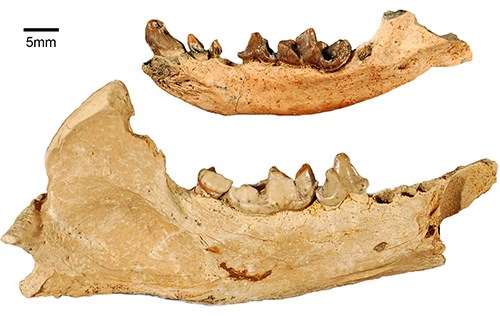Last updated: November 29, 2021
Article
Hagerman's Pliocene Otters

During the Pliocene, 4 to 3 million years ago, Hagerman sat along the shore of the vast, ancient Lake Idaho. The lake, the many waterways that flowed into, and a much wetter climate all helped to support ample wetland habitat and a vibrant community of plants and animals. This picture of the past is supported not only by geologic evidence, but also by the fossil record, which includes an abundance of aquatic species. In addition to beavers, fish, and waterfowl, Pliocene Hagerman was home to two species of otter. The large Satherium piscinarium and its smaller counterpart, Lontra weiri, co-existed in the waters of Pliocene Hagerman, perhaps specializing in different types or sizes of prey.
What Makes an Otter?
Today, there are 13 species of living otters on five continents, including the North American river otter, the giant otter of South America, and the well-known sea otter. This group belongs to the Mustelid family, which includes weasels, skunks, wolverines, and badgers. Otters have special adaptations for spending significant time in water: they have long, slim bodies, short limbs with webbed feet, and powerful tails. Unsurprisingly, their diets are based on fish and invertebrates like clams and mussels.

NPS photo
Hagerman’s Giant Otter
Fossils from the larger of ancient Hagerman’s now-extinct otters, Satherium piscinarium, were first collected in Hagerman during the Smithsonian Expeditions (1929 – 1934). Although the species has been found across North America, some of the best fossil specimens come from Hagerman. This species had broad teeth that may have helped it to crack open the shells of ancient freshwater mussels and snails. Satherium piscinarium is thought to be a relative, and perhaps an ancestor of, the living giant otter of South America, Pteronura brasiliensis.
An Exciting Discovery
For decades, Satherium piscinarium was the only otter known to have lived in Pliocene Hagerman. In 2014, another otter was discovered hiding in plain sight. A jaw and humerus (arm bone) were collected at the site in the 1980s, before the national monument was established. The fossils, housed by the Idaho Museum of Natural History, were originally labelled as another extinct mustelid species, the grison. Hagerman Fossil Beds’ paleontologist, Dr. Kari Prassack, correctly identified the fossils as those of an otter. Dr. Prassack named and described Lontra weiri in a 2016 research paper.
Lontra weiri provides valuable clues about the evolution of otters in North America. The new species belongs to the same genus as the North American river otter (Lontra canadensis) and 3 other species of central and South American otters. Lontra otters were once believed to be recent arrivals from Asia, with the oldest fossils belonging to living species and dating only to the Pleistocene (less than 2 million years old.) The discovery of Lontra weiri, a species that lived in North America over 3 million years ago, indicates that these otters have been here longer than previously thought. However, no other remains of this species have been found, and much of these otters’ origins remains a mystery.
